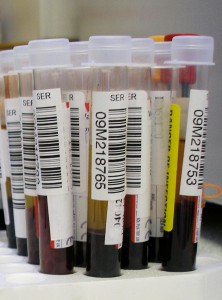
Analyzing blood samples, researchers have found that over one third of chronic kidney diseases are caused by single mutations on single genes
(Image: Graham Colm)
Friedhelm Hildebrandt, MD, receives around one blood sample in the mail per day from a patient with chronic kidney disease. Over 10 years, he’s collected more than 5,000 samples from patients all over the world—in hopes of finding the genetic mutations that cause them and, ultimately, new treatments.
Consider the mutation in an 8-month-old boy from Turkey, who had fluid collection under his skin and elevated protein in his urine—signs that his kidneys were failing. Doctors identified his disease as a form of nephrotic syndrome, one of the three main types of chronic kidney disease. The disease was proving to be hard to treat: Ten weeks of steroids had produced no result, and an immunosuppressant hadn’t been effective enough to justify its harsh side effects.
Only within the last year, genetic research has revealed that more than 30 percent of childhood chronic kidney diseases—like this child’s—stem from single mutations in single genes.
Each individual mutation is rare, but together they affect many of the sickest patients who aren’t helped by current treatments. The severe form of nephrotic syndrome called focal segmental glomerulosclerosis (FSGS), for example, forces children to receive chronic dialysis and, often, a kidney transplant (read more on Vector here). With new high-throughput genetic sequencing technology, Hildebrandt and others are beginning to find and understand the causes of FSGS and other kidney diseases nobody had even thought of as genetic.
“Many of the children that we see probably have a recessive gene as the single cause of their disease,” says Hildebrandt, “and now we can find it. Just two years ago, without whole-exome resequencing, it was impossible. There is a silent revolution going on in pediatric disesases.”
To identify these rare mutations, Hildebrandt’s lab catalogues the protein-coding genes in a blood sample, using a process called whole-exome resequencing, and compares the results with samples from siblings sharing the same disease. This technique has pinpointed mutations in more than 20 different single genes causing different types of kidney disease—including the 8-month-old boy’s FSGS, traced to mutations in the gene ADCK4.
What’s left to find are the extremely rare mutations—the ADCK4 mutation has only been found in 4 in 1,000 people with nephrotic syndrome. Because they are so rare, it can be hard to separate them from the noise of normal human genetic variation.
Adding more complication, several different mutations can lead to the same disease, and, conversely, different mutations on the same gene can have vastly different effects depending on how much function the gene retains: It can be the difference between mild, ongoing kidney disease and severe malformations at birth. Hildebrandt’s lab relies on international collaboration to study as many samples as possible.
And once a mutation is identified, the work is just beginning.
“A protein may have 200 different functions,” says Hildebrandt, “so the minute you know what the defective protein is doesn’t mean you know how the disease works.”
As Hildebrandt shows here, the ADCK4 protein localizes in the mitochondria (left image) and, when absent, causes zebrafish to show symptoms mirroring the human disease (shown at right)
In the lab, he and his colleagues try to determine the mutations’ biological effects and search for potential treatments. In the case of ADCK4, Hildebrandt knocked out the gene in zebrafish. The fish lost protein in the urine and developed puffy eyes—just like the boy’s.
Looking closer, the lab found that zebrafish without ADCK4 were unable to create the coenzyme Q10, which helps generate energy throughout the body and is essential for survival of the cells that form the kidney’s filtration system.
Coenzyme Q10 is commonly available as an over-the-counter supplement, and when it was given to patients with nephrotic syndrome and ADCK4 mutations, the protein loss in the urine stopped. “Suddenly,” Hildebrandt recalls, “we had homed in on a disease pathway and found that there was already a supplement for the substance that was missing.”
It doesn’t happen this way all the time, says Hildebrandt: This was a case where the researchers simply got lucky. “Often, even knowing the recessive mutation, to then delineate what happens in the cell and how the disease mechanism works can still take 10 years or more.”
Even after finding that coenzyme Q10 worked, Hildebrandt’s lab will test a number of different drug treatments. “This is the same approach we use for all the other genes we find,” he says, “because then we may be able to find the first drug ever that works for it.” Zebrafish turn out to be great models for large-scale drug screening, and Hildebrandt sees great potential for drug development partnerships with industry.
The boy from Turkey began taking coenzyme Q10 at one year of age, and his symptoms retreated. Without the treatment, his kidneys would likely have failed within five years—meaning that he would have needed a transplant or lifelong dialysis. But with treatment dictated by an understanding of his mutation, he’ll be able to have normal kidney function.
Hildebrandt anticipates more such examples. “Nobody thought these kidney diseases would have anything to do with genes,” he says, “and now in up to a third we can find the cause. It’s new to us, it’s new to the field. It’s pretty breathtaking.”








